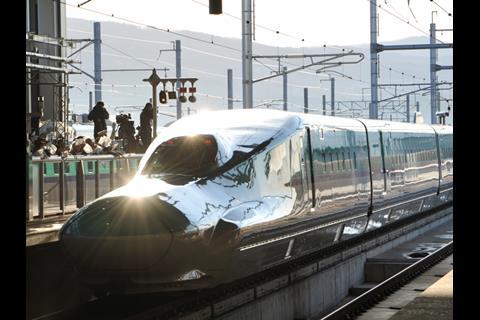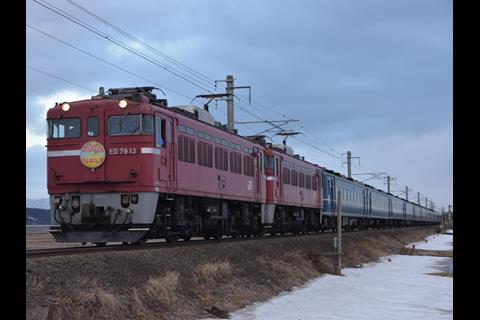JAPAN: High speed services reached Japan’s third main island on March 26, with the inauguration of the first phase of the Hokkaido Shinkansen. Connecting Shin-Aomori in Honshu with Shin-Hakodate-Hokuto in the south of Hokkaido, the 149 km line uses mixed-gauge tracks in the 54 km Seikan Tunnel under the Tsugaru Strait.
Operated by JR Hokkaido, the line forms an end-on connection with JR East’s Tohoku Shinkansen, permitting the operation of through trains to and from Tokyo. These Hayabusa services cover the 863 km in 4 h 2 min. To operate its share of the through service, JR Hokkaido has bought four 10-car Series H5 trainsets, which work in a pool with the similar 320 km/h Series E5 sets operated by JR East.
With a maximum speed of 260 km/h on the new line, the journey time between Shin-Aomori and Shin-Hakodate is reduced to 61 min, 53 min faster than the former EMU service between the two cities. The new Shinkansen station lies approximately 16 km north of Hakodate and is connected to the city by a 1 067 mm gauge shuttle service taking around 25 min.
The line was formally opened with a ceremony at Shin-Hakodate-Hokuto, attended by more than 2 500 people. Minister of Land, Infrastructure, Transport & Tourism Minister Keiichi Ishii, JR Hokkaido President Osamu Shimada and the Governor of Hokkaido Harumi Takahashi flagged off Hayabusa train 10 to Tokyo at 06.35. Meanwhile, the northbound Hayabusa 1 was dispatched from Tokyo by JR East President Tetsuro Tomita, who said ‘our long-cherished dream of seeing a Shinkansen train pass through the Seikan Tunnel has come true.
Governor Takahashi described the opening of the Hokkaido Shinkansen as ‘the beginning, not the end’, calling for the benefits of Shinkansen to be spread ‘to every corner of Hokkaido, promoting local development and revitalisation throughout the island.
Construction of the 211 km extension of the Hokkaido Shinkansen between Shin-Hakkodate and Sapporo was approved in June 2012. Serving intermediate stations at Shin-Yakumo, Oshamanbe, Kucchian, and Shin-Otaru, the line is expected to be completed by 2035, offering a journey time between Tokyo and Sapporo of around 5 h.





















